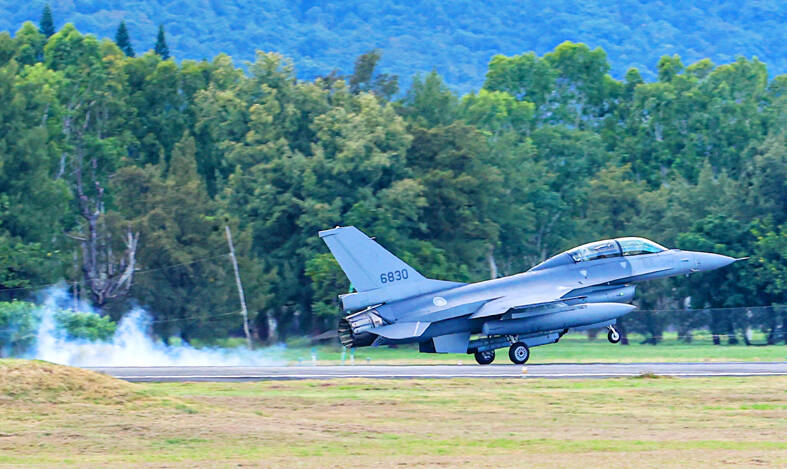The US Department of Defense has identified four possible military courses of action that China could take against Taiwan, but did not offer any guess on when Beijing might be ready to act.
In an annual report to the US Congress released on Tuesday titled Military and Security Developments Involving the People’s Republic of China 2022, the department gave a broad overview of China’s military capabilities, strategy, ambitions and intentions.
The report devoted significant space to developments related to Taiwan, against which it said China had intensified diplomatic, economic, political and military pressure last year.

An F-16V jet takes off from an air force base in Hualien County during military drills on Aug 17.
Photo: CNA
For example, the Chinese People’s Liberation Army (PLA) conducted 20 naval exercises simulating the capture of Taiwan last year, up from 13 a year earlier, it said.
Chinese warplanes, including advanced J-16 fighters, entered Taiwan’s air defense identification zone on 240 days last year, it said.
China now has a range of military courses of action it can take against Taiwan, which vary in feasibility and risk, and can be divided into four general categories, the report said.
First, China could attempt to impose an air and maritime blockade to cut off Taiwan’s vital imports, possibly accompanied by missile attacks or the seizure of Taiwan’s outlying islands, in an effort to force its capitulation, the report said.
This would also likely be complemented by electronic warfare, network attacks and information operations “to further isolate Taiwan’s authorities and populace, and control the international narrative of the conflict,” it said.
Second, Beijing could conduct “limited force or coercive operations,” it said.
In this scenario, China would use “computer network or limited kinetic attacks” against political, military or economic infrastructure to induce fear and degrade the confidence of Taiwanese in their leaders, the report said.
In such an operation, PLA special operations forces could also “infiltrate Taiwan and conduct attacks against infrastructure or leadership targets,” it said.
Third, an air and missile campaign involving precision strikes against key government and military targets to degrade Taiwan’s defenses, “neutralize” its leadership or undermine the public’s resolve to resist might be used, the report said.
Fourth would be an actual invasion of Taiwan, it said.
The invasion tactics China would most likely adopt would be a joint island landing campaign, the report said.
That concept envisions a complex, coordinated campaign to establish a beachhead, build up combat power on Taiwan’s shores and seize key targets across the nation, it said.
While China is continuing to build and rehearse these capabilities, a large-scale amphibious invasion is “one of the most complicated and difficult military operations” and would likely strain China’s armed forces and invite international intervention, the report said.
“Combined with inevitable force attrition, complexity of urban warfare and potential insurgency, these factors make an amphibious invasion of Taiwan a significant political risk for [Chinese President] Xi Jinping (習近平) and the Chinese Communist Party, even assuming a successful landing and breakout,” it said.
Nevertheless, the Pentagon believes that China is already capable of amphibious operations short of a full-scale invasion, such as an invasion of Pratas Island (Dongsha Island, 東沙群島) or Itu Aba Island (Taiping Island, 太平島), or of the better-defended islands of Kinmen and Lienchiang counties, it said.
However, even a limited operation would involve significant “and possibly prohibitive” political risks, because it could galvanize independence sentiment in Taiwan and generate powerful international opposition, the report said.
The report did not set out a timeline on when China might take such actions, although it said that China’s goal of accelerating the integrated development of its military by 2027 could give it “a more credible military tool ... to wield as it pursues Taiwan unification.”
Source: Taipei Times - 2022/12/01




















